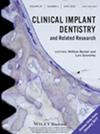Analysis of Risk Factors for Early Implant Failure in the Anterior Region: A Retrospective Study of 2620 Implants
Abstract
Objectives
This study aimed to identify risk factors associated with early implant failure in the anterior maxillary and mandibular regions.
Materials and Methods
A total of 2023 patients with 2620 implants placed in the maxillary and mandibular anterior regions between January 2020 and June 2023 were included in this study. Clinical and radiographic data were extracted from medical records and imaging software. In organizing the information, 19 variables were categorized into patient-related factors (gender, age, periodontitis, reasons for tooth loss, bone quality, and penicillin allergy), implant-related factors (implant system, bone level/soft tissue level, diameter, and length), and surgical factors (jaw position, placement timing, bone grafting, bone compression/splitting surgery, concentrated growth factors (CGFs), bone graft materials, barrier membrane, torque, and healing style). Univariate and multivariate Cox proportional hazards regression models were used to identify significant risk factors for early failure.
Results
The cumulative survival rate (CSR) of all implants after a 0- to 43-month observation period was 95.6% (95% confidence interval [CI]: 94.8%–96.4%). Independent risk factors for early implant failure included non-submerged healing (hazard ratio [HR] = 3.000, 95% CI = 1.712–5.256), torque < 30 N/cm (HR = 13.193, 95% CI = 8.439–20.626), and Type I bone quality (HR = 3.220, 95% CI = 1.413–7.342) (all p < 0.05). Conversely, bone compression or splitting surgery was identified as a protective factor (HR = 0.344, 95% CI = 0.186–0.634). No significant associations were observed for age, reasons for tooth loss, penicillin allergy, use of CGF, or implant characteristics (location, type, length, and diameter).
Conclusion
After 0–43 months of observation, the CSR for 2620 implants placed in 2023 patients was 95.6% (95% CI = 94.8%–96.4%). Torque < 30 N/cm, non-submerged healing, and Type I bone quality were considered independent risk factors for early implant failure in the anterior region.

 求助内容:
求助内容: 应助结果提醒方式:
应助结果提醒方式:


